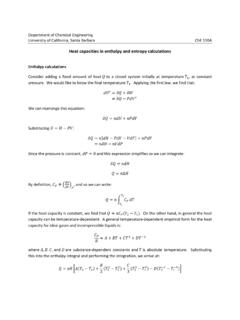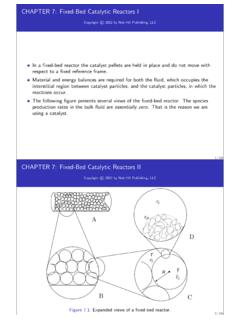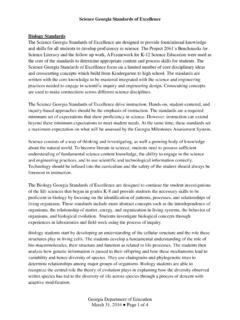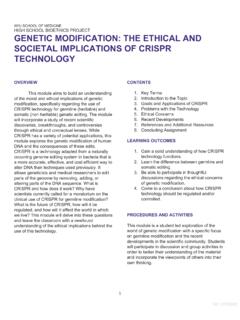Transcription of DNA, RNA, replication, translation, and transcription ...
1 M. S. Shell 2009 1/12 last modified 10/27/2010 DNA, RNA, replication, translation, and transcription Overview Recall the central dogma of biology: DNA ( genetic information in genes) RNA (copies of genes) proteins (functional molecules) DNA structure One monomer unit = deoxyribonucleic acid composed of a base, a sugar (deoxyribose), and a phosphate directionality along the backbone 5 (phosphate) to 3 (OH) Double-strand pairing: complementary base-matching: A-T, C-G base-matching achieved by H-bonding and geometry (long vs short nucleotides) antiparallel (one strand 5 3 , the other 3 5 ) Helical shape nucleotides per turn diameter = 2 nm both major and minor grooves called B-DNA.
2 The helix twist and diameter can also change under dehydrating conditions and methylation to A-DNA and Z-DNA Base-pairing and strand interactions A, G are long (double ring purines) C,T are short (single ring pyrimidines) need one long and one short nucleotide per pair C-G have three hydrogen bonds (slightly stronger matching) A-T have two hydrogen bonds (slightly weaker matching) M. S. Shell 2009 2/12 last modified 10/27/2010 base stacking of aromatic rings allows sharing of pi electrons and adds stability to interior structure of DNA some hydrophobic driving force as well pair structure allows template for semi-conservative copying Information in DNA sequence is the genome genes are stretches of information in the sequence that encode for particular function (usually a particular protein, but sometimes also an RNA sequence) about 20,000 genes in humans typically 1000s of nucleotides long genes can be expressed (use to make proteins) or repressed (not used)
3 Regions of DNA are divided into coding and non-coding segments over 50% of human DNA is non-coding genes can be spliced together genes are organized in the large-scale structure of the DNA in the nucleus In bacteria, genome usually circular The genome in eukaryotes is organized into chromosomes each chromosome a separate DNA molecule human cells contain 46 chromosomes (22 each from mother and father) chromosomes are extended and replicated during interphase portion of the cell cycle extended allows for gene expression chromosomes are condensed, visible with light during cell division (M phase) Special DNA sequences exist in each chromosome replication origins multiple locations where the replication machinery first binds to start replication centromere center pinch point of a chromosome that allows one copy of each to be pulled apart into two daughter cells during division M.
4 S. Shell 2009 3/12 last modified 10/27/2010 telomere specialized sequences at the chromosomes end that facilitate replication there Higher-order DNA structure How do cells efficiently store very long chains of DNA? DNA wraps around protein spools to form nucleosomes Nucleosomes are made of histone proteins Spools organize into chromatin fibers that pack in regular ways, on different length scales Replication DNA replication is semi-conservative one strand from each of the initial two strands end up in a daughter strand Each strand serves as a template for a new strand New strand is formed by complementary base-pairing of the correct nucleotide plus formation of a phosphodiester bond Synthesis begins at replication origins about 100 nucleotides long rich in A-T.
5 Which are easier to pull apart because have 2 rather than 3 hydrogen bonds ~1 in bacteria ~10000 in humans Initiator proteins bind at replication origins and recruit DNA replication machinery proteins DNA polymerase is responsible for catalyzing synthesis of new strands Replication forks form and involve a leading and a lagging strand DNA is directional; two strands are antiparallel DNA polymerase can only synthesize from 5 to 3 direction, adding new nucleotides to the 3 end M. S. Shell 2009 4/12 last modified 10/27/2010 lagging strand must be synthesized by first spooling out some template strand and then synthesizing in reverse Error-correction machinery mutations occur 1 in 10 nucleotides copied evolution, cancer much better error rates than expected simply from base-pairing energetics DNA polymerase proofreads to make sure correct nucleotide is added if not.
6 It excises and goes back to add the correct one Mismatch repair machinery fixes incorrectly added nucleotides not found by DNA polymerase detects nicks in newly created strand Damage to DNA continuously occurs Homologous recombination uses similar sequences in nearby strands in order to fill in excised damaged DNA also the basis of heredity transcription Messenger RNA, or mRNA, is the RNA copies of genes ultimately used to synthesize proteins, although some RNA are the final product themselves M. S. Shell 2009 5/12 last modified 10/27/2010 RNA has some distinctions from DNA ribose rather than deoxyribose sugar (differs in an OH group) uracil instead of thymine (loss of a methyl group) single-stranded, and typically folds into unique shapes, like proteins less chemically stable Other kinds of RNA Ribosomal RNA, rRNA, is RNA that becomes part of the ribosome, the big molecular machine responsible for synthesizing proteins Transfer RNA, tRNA, is used to bring correct amino acids to the ribosome during protein synthesis Micro RNAs (mRNAs)
7 Are important in regulating gene expression others transcription involves the synthesis of rRNA from DNA using RNA polymerase RNA polymerase must unpair and unwind DNA as it is reading it much less accurate than replication errors of 1 in 10 protein synthesis can tolerate more errors multiple RNAs can be sequenced from the same gene at the same time In bacteria: RNA polymerase binds to specific regions of the DNA called promoters, specific nucleotide sequences Promoters orient polymerase in a specific direction RNA polymerase binds to the promoter with the help of an accessory protein, called a sigma factor RNA transcript is synthesized by ribonucleotide triphosphate additions Synthesis stops at a terminator sequence, typically of poly A-T stretches of DNA M.
8 S. Shell 2009 6/12 last modified 10/27/2010 In eukaryotes, the situation is different in a number of ways: 1. Different kinds of RNA polymerases, depending on whether the product is protein or RNA 2. RNA polymerase requires a number of helper proteins to bind to DNA and initiate RNA synthesis transcription factors 3. transcription factor TFIID binds to a specific DNA sequence upstream 25 nucleotides from the region coding for the protein TATA sequence or TATA box 4. Other proteins assemble to form a large transcription complex 5. Chromatin-remodeling proteins are involved to make DNA accessible from the wound histone structure 6. RNA chemically modified with a methylated guanine at the 5 end and a poly-A sequence at the 3 end these help the ribosome later ensure that the complete recipe for a protein is there 7.
9 RNA is processed after synthesis splicing to remove noncoding regions called introns 8. The nuclear pore complex selectively exports complete, spliced mRNA molecules to the cytosol Splicing has evolutionary advantages promotes diversity of proteins produced from a single gene alternative splicing enables formation of new proteins from combinations of different genes separated by long noncoding regions Translation Information transmission 4 bases in DNA/RNA to 20 amino acids in proteins translation since the chemical language is different How many nucleotides needed to specify each amino acid? Two = 16 combinations not enough! Three = 64 combinations plenty!
10 M. S. Shell 2009 7/12 last modified 10/27/2010 Processed ( , spliced) mRNA is read in groups of three nucleotides called codons redundancy of codons for different amino acids typically the last nucleotide is variable three possible reading frames depending on starting nucleotide transfer RNAs (tRNAs) are the intermediates between nucleotides and amino acids about 80 nucleotides long have specific 3D shape, like an L at one end: anticodon that base-pairs with mRNA at the other end: covalently coupled amino acid different tRNAs for each amino acid type base pairing weakest at third wobble nucleotide (why it is most variable) tRNAs are charged with an amino acid by aminoacyl tRNA synthetases that ensure correct addition of individual amino acids to corresponding tRNA The synthesis of proteins is choreographed by large molecular machines called ribosomes large and small subunits = ~82 proteins (1/3) plus 4 ribosomal RNA (rRNA) strands (2/3) overall structure and catalytic activity dictated by RNA ribozyme huge!













